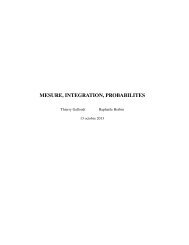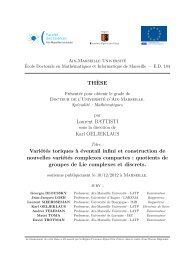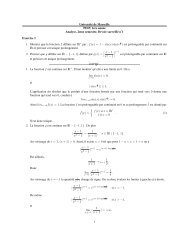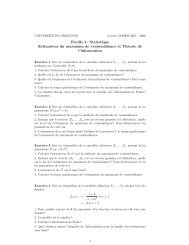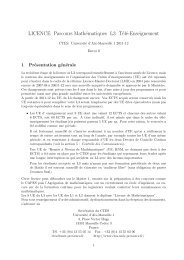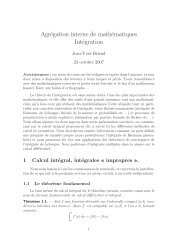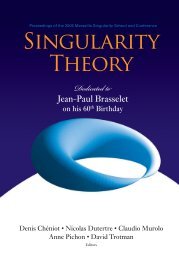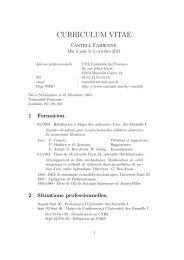Marc Raimondo - CMI
Marc Raimondo - CMI
Marc Raimondo - CMI
Create successful ePaper yourself
Turn your PDF publications into a flip-book with our unique Google optimized e-Paper software.
<strong>Marc</strong> <strong>Raimondo</strong><br />
Luminy 12/08 – p.1
<strong>Marc</strong> at A.N.U.<br />
John Dedman Mathematical Sciences<br />
Building [27]<br />
John Dedman Mathematical Sciences Building, JD<br />
This building<br />
houses:<br />
•<br />
•<br />
•<br />
•<br />
Luminy 12/08 – p.2
The Annals of Statistics<br />
2004, Vol. 32, No. 5, 1781–1804<br />
DOI 10.1214/009053604000000391<br />
© Institute of Mathematical Statistics, 2004<br />
PERIODIC BOXCAR DECONVOLUTION AND DIOPHANTINE<br />
APPROXIMATION<br />
BY IAIN M. JOHNSTONE 1 AND MARC RAIMONDO 2<br />
Stanford University and University of Sydney<br />
We consider the nonparametric estimation of a periodic function that is<br />
observed in additive Gaussian white noise after convolution with a “boxcar,”<br />
the indicator function of an interval. This is an idealized model for the<br />
problem of recovery of noisy signals and images observed with “motion<br />
blur.” If the length of the boxcar is rational, then certain frequencies are<br />
irretreviably lost in the periodic model. We consider the rate of convergence<br />
of estimators when the length of the boxcar is irrational, using classical<br />
results on approximation of irrationals by continued fractions. A basic<br />
question of interest is whether the minimax rate of convergence is slower<br />
Luminy 12/08 – p.3
� Jan - Jun, 1999<br />
� postdoc<br />
� ’the bicycle’<br />
� Aug, 2001<br />
� Jan - Feb 2002<br />
� Oct - Nov 2003<br />
<strong>Marc</strong>’s visits to Stanford<br />
Luminy 12/08 – p.4
Effect of Ageing on Morphologic and Clinical<br />
Predictors of Prostate Cancer Progression<br />
Thomas A. Stamey, MD,* <strong>Marc</strong> <strong>Raimondo</strong>, PhD, †<br />
Cheryl M. Yemoto, BS,* John E. McNeal, MD,* and<br />
Iain M. Johnstone, PhD †<br />
*Department of Urology School of Medicine, Stanford University,<br />
Stanford, California, U.S.A.<br />
† Department of Statistics, Stanford University,<br />
Stanford, California, U.S.A.<br />
© 2000, Blackwell Science, Inc. 1095-5100/00/$15.00/0<br />
The Prostate Journal, Volume 2, Number 3, 2000 157–162 157<br />
Luminy 12/08 – p.5
J. R. Statist. Soc. B (2004)<br />
66, Part 3, pp. 547–573<br />
Wavelet deconvolution in a periodic setting<br />
Iain M. Johnstone,<br />
Stanford University, USA<br />
Gérard Kerkyacharian,<br />
Centre National de la Recherche Scientifique and Université de Paris X, France<br />
Dominique Picard<br />
Centre National de la Recherche Scientifique and Université de Paris VII, France<br />
and <strong>Marc</strong> <strong>Raimondo</strong><br />
University of Sydney, Australia<br />
[Read before The Royal Statistical Society at a meeting organized by the Research Section on<br />
‘Statistical approaches to inverse problems’ on Wednesday, December 10th, 2003, Professor<br />
J. T. Kent in the Chair ]<br />
Luminy 12/08 – p.6
<strong>Marc</strong> <strong>Raimondo</strong> Memorial Session:<br />
–<br />
Null distributions for largest eigenvalues in<br />
multivariate analysis<br />
Iain Johnstone, Statistics, Stanford<br />
imj@stanford.edu<br />
Luminy, December 16, 2008<br />
Luminy 12/08 – p.7
Theme<br />
� Many problems of classical multivariate statistics involve<br />
eigenvalues x1 > x2 > ... > xp<br />
� Asymptotics in p ⇒ useful information, [even p small]<br />
� Illustrate for null distributions for x1<br />
Luminy 12/08 – p.8
Theme<br />
� Many problems of classical multivariate statistics involve<br />
eigenvalues x1 > x2 > ... > xp<br />
� Asymptotics in p ⇒ useful information, [even p small]<br />
� Illustrate for null distributions for x1<br />
Example: (multiple) Regression.<br />
y = X β + ǫ<br />
n×p n×q q×p n×p<br />
ǫ ∼ N(0,In ⊗ Ip).<br />
Tests of H0 : β = 0 use roots of det[A + xi(A + B)] = 0.<br />
A = SSH = ˆ β T X T X ˆ β “Hypothesis”<br />
B = SSE = y T (I − PX)y “Error”<br />
Luminy 12/08 – p.9
A ∼ Wp(n1,I)<br />
B ∼ Wp(n2,I)<br />
Double Wishart Setting<br />
Common feature: roots := (xi) p<br />
i=1<br />
Single Wishart<br />
� Principal Component analysis<br />
� Factor analysis<br />
� Multidimensional scaling<br />
2 independent Wisharts, p ≤ n1,n2<br />
“null hypothesis” setting<br />
det[x(A + B) − A] = 0<br />
of generalized eigenproblem:<br />
Double Wishart<br />
� Canonical correlation analysis<br />
� Multivariate Analysis of Variance<br />
(MANOVA)<br />
� Multivarate regression analysis<br />
� Discriminant analysis<br />
� Tests of equality of covariance matrices<br />
Luminy 12/08 – p.10
Joint density of eigenvalues<br />
Single Wishart: det[A − xiI] = 0.<br />
Double Wishart: det[A − xi(A + B)] = 0.<br />
In each case, (Fisher, Girshick, Hsu, Mood, Roy, (1939)):<br />
f(x1,...,xp) = c �<br />
w 1/2 (xi) �<br />
(xi−xj) x1 ≥ ... ≥ xp<br />
i<br />
i
I. Setting<br />
Outline<br />
1. Single & Double Wishart, examples<br />
II. Largest Eigenvalue: Limiting Law (H0)<br />
1. Gaussian<br />
2. Laguerre/Single W.<br />
3. Jacobi/Double W.<br />
III. Largest Eigenvalue: Concentration<br />
1. Single W.<br />
2. Double W.<br />
Luminy 12/08 – p.12
Symmetric Gaussian matrices<br />
A – symmetric N × N matrix drawn from (GOE)<br />
f(A) = c exp{− 1<br />
2 tr(AT A)}.<br />
[for GUE: complex Hermitian]. Largest eigenvalue:<br />
Centering and scaling constants:<br />
θN = λmax(A)<br />
µN = √ 2N, σN = 2 −1/2 N −1/6<br />
Tracy-Widom limit: TW (1994, 1996) For β = 1, 2, 4 (R, C, Q),<br />
θN − µN<br />
σN<br />
D<br />
⇒ Fβ.<br />
Luminy 12/08 – p.13
Tracy-Widom distributions (1994,96)<br />
-4 -2 0 2 4<br />
F2(s) = e − R ∞<br />
s (x−s)2 q(x)dx<br />
F1(s) 2 = F2(s)e − R ∞<br />
s q(x)dx .<br />
q ′′ = sq + 2q 3<br />
(Painlevé II)<br />
q(s) ∼ Ai(s) as s → ∞<br />
Right tail decay: 1 − Fβ(s) ≈ e−(2/3)s3/2 .<br />
Rate of convergence: First order N −1/3 , Choup (2006,07)<br />
“Second-order”: J + Ma (2008) For β = 1, 2, with µN = √ 2N+1,<br />
|P {λmax(A) ≤ µN + σNs} − Fβ(s)| ≤ CN −2/3 e −s/2 .<br />
Luminy 12/08 – p.14
f(x)<br />
0.35<br />
0.3<br />
0.25<br />
0.2<br />
0.15<br />
0.1<br />
0.05<br />
Approximations at N = 2<br />
Density Plot: n =2<br />
simulated percentiles<br />
TW1<br />
empirical 6<br />
4<br />
2<br />
0<br />
−2<br />
−4<br />
−6<br />
Probability Plot: n =2<br />
0<br />
−8 −6 −4 −2 0 2 4 −66 −4 −2 0 2 4 6<br />
x<br />
TW percentiles<br />
– Better approximation in right tail : location of turning point of<br />
Airy function<br />
Luminy 12/08 – p.15
f(x)<br />
0.35<br />
0.3<br />
0.25<br />
0.2<br />
0.15<br />
0.1<br />
0.05<br />
Approximations at N = 10<br />
Density Plot: n =10<br />
simulated percentiles<br />
TW1<br />
empirical 6<br />
4<br />
2<br />
0<br />
−2<br />
−4<br />
−6<br />
Probability Plot: n =10<br />
0<br />
−8 −6 −4 −2 0 2 4 −66 −4 −2 0 2 4 6<br />
x<br />
TW percentiles<br />
Luminy 12/08 – p.16
I. Setting<br />
Outline<br />
1. Single & Double Wishart, examples<br />
II. Largest Eigenvalue: Limiting Law (H0)<br />
1. Gaussian<br />
2. Laguerre/Single W.<br />
3. Jacobi/Double W.<br />
III. Largest Eigenvalue: Concentration<br />
1. Single W.<br />
2. Double W.<br />
Luminy 12/08 – p.17
Tracy Widom Limits<br />
Theorem For {real, complex}, {single, double } Wishart matrices,<br />
if n/p → γ, [or (n1/p,n2/p) → (γ1,γ2),] then<br />
P {n ˆ ℓ1 ≤ µnp + σnps|H0} → Fβ(s)<br />
– “universality” in RMT (Deift, 06 ICM)<br />
Single Wishart: β = 2 (Johansson, 00), β = 1 (J, 01)<br />
“Microarray case” (El Karoui, 03) β = 1, 2,<br />
n,p → ∞, n/p → 0, ∞.<br />
Non Gaussian: (Soshnikov, 02, 06; S. + Fyodorov, 06)<br />
� subGaussian: n − p = O(p 1/3 ) ⇒ TW limit<br />
� heavy tails (e.g. Cauchy) ⇒ Poisson process limit<br />
Luminy 12/08 – p.18
Second order accuracy<br />
For {real, complex}, {single, double } Wishart matrices, if<br />
n/p → γ, [or (n1/p,n2/p) → (γ1,γ2),] then<br />
|P {n ˆ ℓ1 ≤ µnp + σnps|H0} − Fβ(s)| ≤ Ce −cs p −2/3 .<br />
Single Wishart Complex: El Karoui (2006).<br />
Real: Ma (2008)<br />
µnp =<br />
σnp =<br />
��<br />
n−1 2 +<br />
��<br />
n−1 2 +<br />
�<br />
�<br />
p− 1<br />
2<br />
p− 1<br />
2<br />
� 2<br />
� � 1<br />
√n− 1<br />
2<br />
+ 1<br />
√ p− 1<br />
2<br />
� 1/3<br />
.<br />
Luminy 12/08 – p.19
Beyond the “Null Hypothesis”<br />
Classical RMT ensembles (e.g. Wp(n,I))<br />
↔ “null hypothesis”, symmetry, no structure.<br />
For Wp(n, Σ): For what conditions on Σ does<br />
Some answers:<br />
P { ˆ ℓ1 ≤ µnp(Σ) + σnp(Σ)s} → Fβ(s) ??<br />
� sufficiently many ℓk(Σ) accumulate near ℓ1(Σ) (C)<br />
El Karoui, 2007<br />
� small number of (not too!) isolated ℓi(Σ)<br />
Baik-Ben Arous-Peché, 2005, Baik-Silverstein 2006, Paul 2007<br />
Harding (2008, Economics Letters)<br />
Luminy 12/08 – p.20
I. Setting<br />
Outline<br />
1. Single & Double Wishart, examples<br />
II. Largest Eigenvalue: Limiting Law (H0)<br />
1. Gaussian<br />
2. Laguerre/Single W.<br />
3. Jacobi/Double W.<br />
III. Largest Eigenvalue: Concentration<br />
1. Single W.<br />
2. Double W.<br />
Luminy 12/08 – p.21
Roy’s Greatest Root Test: Package Output<br />
SAS: (From Gledhill et. al.: NOAA Fisheries Reef Fish Video Surveys.)<br />
Table 18. Multivariate statistics and F approximations for the CANDISC<br />
procedure ran with all mincount and habitat data.<br />
S=5 M=2 N=48.5<br />
Statistic Value F Value Num DF Den DF Pr > F<br />
Wilks' Lambda 0.58109196 1.15 50 454.87 0.2325<br />
Pillai's Trace 0.50115530 1.15 50 515 0.2342<br />
Hotelling-Lawley Trace 0.59036501 1.15 50 305.82 0.2355<br />
Roy's Greatest Root 0.26759820 2.76 10 103 0.0047<br />
NOTE: F Statistic for Roy's Greatest Root is an upper bound.<br />
R: (car, heplots packages, Fox et. al.)<br />
Multivariate Tests:<br />
Df test stat approx F num Df den Df Pr(>F)<br />
Pillai 5.0000 0.417938 1.845226 15.0000 171.0000 0.0320861 *<br />
Wilks 5.0000 0.623582 1.893613 15.0000 152.2322 0.0276949 *<br />
Hotelling-Lawley 5.0000 0.538651 1.927175 15.0000 161.0000 0.0239619 *<br />
Roy<br />
---<br />
5.0000 0.384649 4.384997 5.0000 57.0000 0.0019053 **<br />
Signif. codes: 0 ’***’ 0.001 ’**’ 0.01 ’*’ 0.05 ’.’ 0.1 ’ ’ 1<br />
Luminy 12/08 – p.22
The Tracy-Widom approximation<br />
Let W = logit(x1) = log(x1/(1 − x1)).<br />
Result: [IMJ] As p ∝ n1,n2 → ∞, (and with O(p −2/3 ) error):<br />
In other words:<br />
Percentiles fα:<br />
f.90 = 0.4501<br />
f.95 = 0.9793<br />
f.99 = 2.0234<br />
W − µp<br />
σp<br />
D<br />
⇒ W∞ ∼ F1.<br />
x1 ≈ eµ+σW∞<br />
. µ+σW∞ 1 + e<br />
0.3<br />
0.25<br />
0.2<br />
0.15<br />
0.1<br />
0.05<br />
-4 -2 2 4<br />
Luminy 12/08 – p.23
Centering and Scaling Constants<br />
� set N = n1 + n2 − 1<br />
� define γ, φ from<br />
sin 2 (γ/2) = (p − 1<br />
2 )/N, sin2 (φ/2) = (n1 − 1<br />
2 )/N<br />
� Then µ and σ are given by<br />
�<br />
φ + γ<br />
�<br />
µp = 2 log tan , σ<br />
2<br />
3 p<br />
= 16<br />
N 2<br />
� (given a table of F1), straightforward to code:<br />
papptw, qapptw, rapptw.<br />
1<br />
sin 2 (φ + γ) sin φ sin γ .<br />
Luminy 12/08 – p.24
Accuracy of approximate α th percentile<br />
Approximate percentile using Tracy-Widom percentile fα:<br />
xα = x TW<br />
α (p,n1,n2) = e µp+fασp /(1 + e µp+fασp ).<br />
William Chen’s tables: (2003, 2004a, 2002, 2004b) ⇒ can compare<br />
� ’Exact’ xα(p,n1,n2) with<br />
� T-W approx x TW<br />
α (p,n1,n2).<br />
Relative error: r = (x TW<br />
α /xα) − 1.<br />
Tracy-Widom based on p → ∞, but try p = 2 as n1,n2 vary<br />
Luminy 12/08 – p.25
θ α<br />
log 10 n<br />
1<br />
0.5<br />
TW<br />
Exact<br />
p = 2 at 95th percentile<br />
n = 2<br />
n = 5<br />
n = 10<br />
n = 20<br />
n = 40<br />
n = 100<br />
n = 500<br />
0<br />
0 5 10 15<br />
m<br />
3<br />
0.070.08<br />
2<br />
1<br />
0.06<br />
0.02<br />
0.05<br />
0.04<br />
0.03<br />
TW<br />
Contours of relative error r = (θ /θα )−1<br />
α<br />
0.01<br />
0.03<br />
0.02<br />
0.02<br />
0.02<br />
0.01 0.01<br />
0<br />
0 5 10 15<br />
m<br />
Luminy 12/08 – p.26
θ α<br />
log 10 n<br />
1<br />
0.5<br />
p = 4 at 90th percentile<br />
n = 2<br />
n = 5<br />
n = 10<br />
n = 20<br />
n = 40<br />
0<br />
0 5<br />
n = 100<br />
n = 500<br />
10<br />
TW<br />
Exact<br />
15<br />
m<br />
3<br />
2<br />
1<br />
0.018<br />
0.016<br />
TW<br />
90th %tile, S=4, Contours of relative error r = (θ /θα )−1<br />
α<br />
0.01<br />
0.012 0.012<br />
0.014<br />
0.012<br />
0.008<br />
0.006<br />
0.004<br />
0.01<br />
0.01<br />
0.008<br />
0.008<br />
0.008<br />
0.006 0.006<br />
0.004 0.004<br />
0.002<br />
0<br />
0 5 10 15<br />
m<br />
Luminy 12/08 – p.27
Summary (for Part II)<br />
T-W approximation to null distribution of Roy’s largest root:<br />
� Conventional percentiles: generally accurate to < 10%<br />
relative error<br />
� [Rough p−value assessments: qualitatively o.k. over many<br />
orders of magnitude]<br />
� Similar O(N −2/3 ) approximations for Wishart and Gaussian.<br />
Recommend: Tracy-Widom approximation replace F − lower<br />
bound in default package printouts<br />
Luminy 12/08 – p.28
I. Setting<br />
Outline<br />
1. Single & Double Wishart, examples<br />
II. Largest Eigenvalue: Limiting Law (H0)<br />
1. Gaussian<br />
2. Laguerre/Single W.<br />
3. Jacobi/Double W.<br />
III. Largest Eigenvalue: Concentration<br />
1. Single W.<br />
2. Double W.<br />
Luminy 12/08 – p.29
Wishart: Concentration for l1<br />
A ∼ Wp(n,I), A = X T X X ∼ N(0,In ⊗ Ip)<br />
Theorem (e.g. Davidson-Szarek, 2001) With l1(A) = σ 2 1(X),<br />
and<br />
P {σ1(X) > Eσ1(X) + √ nt} ≤ e −nt2 /2 ,<br />
Eσ1(X) ≤ √ n + √ p.<br />
from Standard Result: If X ∼ Nm(0,I) and f : R m → R is<br />
Lipschitz-1 (implied by |∇f| ≤ 1), then<br />
P {f(X) > Ef(X) + s} ≤ e −s2 /2 .<br />
Luminy 12/08 – p.30
‘Small’ vs. ‘Large’ Deviations<br />
Rescale X ∼ N(0,In ⊗ Ip)/ √ n so that Eσ1(X) ≈ 1 + √ γ.<br />
Tracy-Widom limit suggests for t ≈ sn −2/3 ,<br />
P {σ1 ≥ Eσ1 + ct} ≈ e −(2/3)nt3/2<br />
.<br />
Lipschitz concentration of measure ⇒ ∀t > 0<br />
P {σ1 ≥ Eσ1 + t} ≤ e −nt2 /2 .<br />
� Not optimal (though simple) for ‘small’ deviations t ≪ 1<br />
� Effective for ’large’ deviations t > 1<br />
(recent: Majumdar-Vargassola)<br />
Luminy 12/08 – p.31
Motivations:<br />
� analog of Davidson-Szarek<br />
Double Wishart<br />
� arises in Candes-Tao sparse linear regression, Y = Aβ + ǫ,<br />
restricted orthogonality constants θS,S ′, and analogs γS,S ′:<br />
〈ATv,AT ′v′ 〉 ≤ θS,S ′�v��v′ � (≤ γS,S ′�ATv��AT ′v′ �).<br />
Use CCA form: X ∼ N(0,In ⊗ Ip) ⊥ Y ∼ N(0,In ⊗ Iq)<br />
Rp,q;n(X,Y ) = max{Corr(Xu,Y v) : �u� = �v� = 1}<br />
Luminy 12/08 – p.32
Rmax as singular value<br />
Use SVD: X = UXDXV T X , Y = UY DY V T<br />
Y<br />
⇒ R(X,Y ) = σ1(U T XUY ), with<br />
UX ∈ Vn,p – Stiefel manifold of orthonormal p−frames, etc<br />
Claim (provisional!)<br />
P {σ1 ≥ Eσ1 + t} ≤ e −(n−2)t2 /8 .<br />
⇒ other double Wishart cases (regression, MANOVA, etc).<br />
Luminy 12/08 – p.33
Concentration for Riemannian manifolds<br />
Theorem (Ledoux, 1992) Assume:<br />
(1. manifold) (X,g) compact, connected, smooth Riemannian<br />
manifold, dimension ≥ 2<br />
(2. volume) dµ normalized Riemannian volume element<br />
(3. Lipschitz) F 1−Lipschitz on X, i.e. |∇F | ≤ 1<br />
(4. curvature) c(X) = inf{Ric(∇f, ∇f) : |∇f| = 1}<br />
Then<br />
µ{F ≥<br />
�<br />
Ricci curvature<br />
Fdµ + t} ≤ e −ct2 /2 .<br />
Need to interpret (1) - (4) for F = σ1(U T X UY ) = R(X,Y ).<br />
Luminy 12/08 – p.34
<strong>Marc</strong> <strong>Raimondo</strong><br />
The Talented Student Program:<br />
an integrated learning solution<br />
Hugh Miller and <strong>Marc</strong> <strong>Raimondo</strong>,<br />
School of Mathematics and Statistics<br />
Luminy 12/08 – p.35
References<br />
THANK YOU!<br />
IMJ, “High Dimensional Statistical Inference and Random Matrices”, Proc<br />
ICM 2006, Vol 1, 307–333.<br />
IMJ, “Multivariate Analysis and Jacobi Ensembles: Largest eigenvalue,<br />
Tracy-Widom Limits and Rates of Convergence”, arXiv:0803.3408, Ann.<br />
Statist. in press.<br />
Webpage: www-stat.stanford.edu/˜imj<br />
Luminy 12/08 – p.36
Determinant representation:<br />
Correlation function:<br />
SN,2(x,y) =<br />
Unitary Case<br />
P {max xj ≤ x0} = det(I − SN,2χ0).<br />
N−1 �<br />
k=0<br />
= 1<br />
� ∞<br />
2<br />
0<br />
Hermite polynomials (normalized):<br />
�<br />
φk(x)φk(y), χ0 = I (x0,∞)<br />
φ(x + z)ψ(y + z) + ψ(x + z)φ(y + z)dz.<br />
φk(x) = cke −x2 /2 Hk(x), φ(x) = (2N) 1/4 φN(x),<br />
φk(x)φl(x)e −x2<br />
dx = δkl, ψ(x) = (2N) 1/4 φN−1(x).<br />
Luminy 12/08 – p.37
Rescaling and convergence to Airy function<br />
Centred and scaled (weighted) polynomials<br />
φτ(s) = (2N) 1/4 φN(uN + τNs),<br />
ψτ(s) = (2N) 1/4 φN−1(uN−1 + τNs)<br />
both satisfy differential equation<br />
w ′′ N(s) = s(1 + O(N −1 ))wN(s).<br />
Liouville-Green theory shows convergence to Airy A(s), solving<br />
with O(N −2/3 ) rate:<br />
A ′′ (s) = sA(s),<br />
|φτ(s) − A(s)| ≤ CN −2/3 e −s/2 .<br />
Luminy 12/08 – p.38
After rescaling:<br />
Sτ(s,t) = 1<br />
2<br />
Unitary Case - Convergence<br />
P {λmax ≤ µ + sσ} = det(I − Sτ),<br />
� ∞<br />
Limit: Tracy-Widom F2:<br />
0<br />
φτ(s + w)ψτ(t + w) + ψτ(s + w)φτ(t + w)dw<br />
F2(s) = det(I − SA)<br />
SA(s,t) =<br />
� ∞<br />
0<br />
A(s + w)A(t + w)dw<br />
Bound �Sτ − SA�1 using convergence of φτ,ψτ to A at O(N −2/3 ):<br />
|det(I − Sτ) − det(I − SA)| ≤ �Sτ − SA�1 · exp(�Sτ � + �SA� + 1)<br />
Luminy 12/08 – p.39
Orthogonal Case<br />
P { max<br />
1≤j≤N+1 xj ≤ x0} = � det(I − KN+1χ0),<br />
⎛ ⎞ ⎛ ⎞<br />
I<br />
KN+1(x,y) = ⎝<br />
ǫ1<br />
−∂2<br />
0 0<br />
⎠SN+1,1(x,y) − ⎝ ⎠<br />
T<br />
ǫ(x − y) 0<br />
∂2 ↔ ∂/∂y<br />
ǫ1 ↔ convolution in x with ǫ(x) = 1<br />
2 sgn(x)<br />
T ↔ transpose x,y<br />
Key identity relates orthogonal at N + 1 to unitary at N :<br />
SN+1,1(x,y) = SN,2(x,y) + 1<br />
2 φ(x)ǫψ(y).<br />
Luminy 12/08 – p.40
Orthogonal Case - Convergence<br />
P { max<br />
1≤j≤N+1 xj ≤ x0} = � det(I − KN+1χ0),<br />
F1(s) = � ⎛<br />
det(I − KGOE)<br />
⎞<br />
I<br />
Kτ(s,t) = ⎝<br />
ǫ1<br />
−∂2<br />
⎠(SN,2,τ(s,t) +<br />
T<br />
1<br />
2φτ(s)ǫψτ(t)) ⎛ ⎞<br />
⎛ ⎞<br />
0 0<br />
− ⎝ ⎠<br />
ǫ(x − y) 0<br />
I<br />
KGOE(s,t) = ⎝<br />
ǫ1<br />
−∂2<br />
⎠(SA(s,t) +<br />
T<br />
1<br />
⎛ ⎞<br />
2A(s)ǫA(t)) 0 0<br />
− ⎝ ⎠.<br />
ǫ(x − y) 0<br />
where O(N −1/3 ) terms cancel:<br />
Sτ(s,t) = SA(s,t) − ∆NA(s)A(t) + O(N −2/3 ),<br />
1<br />
2 φτ(s)ǫψτ(t) = 1<br />
2 A(s)(ǫA)(t) + ∆NA(s)A(t) + O(N −2/3 ).<br />
Luminy 12/08 – p.41
Accuracy of approximate p−values<br />
Multivariate Tests:<br />
Df test stat approx F num Df den Df Pr(>F)<br />
Pillai 5.00 0.6658 3.5369 15.00 186.00 2.309e-05 ***<br />
Wilks 5.00 0.4418 3.8118 15.00 166.03 8.275e-06 ***<br />
Hotelling-Lawley 5.00 1.0309 4.0321 15.00 176.00 2.787e-06 ***<br />
Roy<br />
---<br />
5.00 0.7574 9.3924 5.00 62.00 1.062e-06 ***<br />
Signif. codes: 0 ’***’ 0.001 ’**’ 0.01 ’*’ 0.05 ’.’ 0.1 ’ ’ 1<br />
� ’Exact’ percentile: from Koev’s qmaxeigjacobi<br />
� Tracy-Widom p−value (using table of F1):<br />
pTW(xα) = 1 − F1((logit(xα) − µ)/σ),<br />
� p− value derived from F distribution lower bound:<br />
pF(xα) = 1 − Fn1,n2(n2x/(n1(1 − x))),<br />
Luminy 12/08 – p.42
Tail p−values: s = 2 variables<br />
F bound gives wrong order of magnitude;<br />
Tracy-Widom gives qualitatively correct p−value assessment.<br />
S = 2, M = −0.5, N = 2<br />
Largest Root Exact Tracy-Widom F<br />
0.663 0.1 0.119 0.0223<br />
0.737 0.05 0.066 0.00933<br />
0.850 0.01 0.0169 0.00131<br />
0.881 0.005 0.00927 0.000573<br />
0.931 0.001 0.00222 8.49e-005<br />
0.968 0.0001 0.000251 5.65e-006<br />
0.985 1e-005 2.38e-005 3.81e-007<br />
0.993 1e-006 1.89e-006 2.58e-008<br />
Luminy 12/08 – p.43
s = 6 variables<br />
F bound wrong by many orders of magnitude;<br />
Tracy-Widom gives qualitatively correct p−value assessment.<br />
S = 6, M = 5, N = 10<br />
Largest Root Exact Tracy-Widom F<br />
0.757 0.1 0.108 0.000117<br />
0.781 0.05 0.0557 3.63e-005<br />
0.823 0.01 0.0119 2.99e-006<br />
0.837 0.005 0.00606 1.08e-006<br />
0.864 0.001 0.00125 1.1e-007<br />
0.894 0.0001 0.000125 4.75e-009<br />
0.917 1e-005 1.17e-005 2.25e-010<br />
0.934 1e-006 1.03e-006 1.13e-011<br />
Luminy 12/08 – p.44



